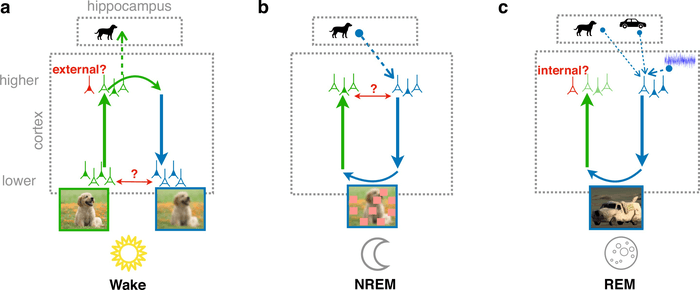BERN, Switzerland — Strange dreams often leave the dreamer looking for the hidden meaning in these odd visions. However, a new study finds the more bizarre your dream is, the better it may be for your brain.
Researchers from the University of Bern, working with the Human Brain Project, theorize that realistic-but-strange dreams actually help the brain learn from previous experiences.
Previous studies have documented the importance of sleep and dreaming for human memory and learning skills. Moreover, studies have revealed how impactful a single night of poor sleep can be for cognitive health.
“What we lack is a theory that ties this together with consolidation of experiences, generalization of concepts and creativity,” explains study lead author Nicolas Deperrois in a media release.
Dreams change during the different phases of sleep
The researchers note that people commonly experience two types of sleep phases during the night. The first is non-REM sleep, where the brain “replays” all the things that stimulated the sleeper’s brain while they were awake. The next is REM (rapid eye movement) sleep, where sudden bursts of intense brain activity cause the sleeper to have vivid dreams.
To examine how these different sleep phases affect learning, the team used machine learning systems to simulate what happens in an actual brain cortex. To insert an “element of unusualness” to these computer-simulated dreams, researchers took inspiration from a machine learning technique called Generative Adversarial Networks (GANs).
In GANs, two neural networks compete with each other to create new data using the same information scientists fed them. In this study, researchers fed the networks a collection of simple pictures, ranging from animals to cars. The process led to the networks creating brand new image which still look realistic to humans.
Study authors then simulated a person’s cortex during three phases: wakefulness, non-REM sleep, and REM sleep. While awake, researchers exposed the brain model to pictures of boats, cars, dogs, and other simple images. During non-REM sleep, the model “replayed” these images, but also experienced some mental blockages.
However, during REM sleep, the model created new sensory inputs using GANs. This led to twisted-but-realistic versions of the images the brain saw while it was awake — including strange combinations like a giant dog car.
“Non-REM and REM dreams become more realistic as our model learns,” explains research team leader Jakob Jordan. “While non-REM dreams resemble waking experiences quite closely, REM dreams tend to creatively combine these experiences.”

(CREDIT: Deperrois et al. eLife 2022;11:e76384)
Poor sleep affects our ability to learn from dreams
Researchers tested the performance of their brain model using a simple classifier to evaluate how easy it is to identify objects from their cortical representations. Simply put, the test looks at how easy it is to still recognize images from the waking world when they appear in our dreams.
Interestingly, the team found that when they suppressed REM sleep or when the dreams were less creative, the accuracy of this classifier dropped. When scientists removed non-REM sleep, the brain cortex became more sensitive to sensory blockages.
“We think these findings suggest a simple evolutionary role for dreams, without interpreting their exact meaning,” Deperrois concludes. “It shouldn’t be surprising that dreams are bizarre: this bizarreness serves a purpose. The next time you’re having crazy dreams, maybe don’t try to find a deeper meaning – your brain may be simply organizing your experiences.”
The findings appear in the journal eLife.

